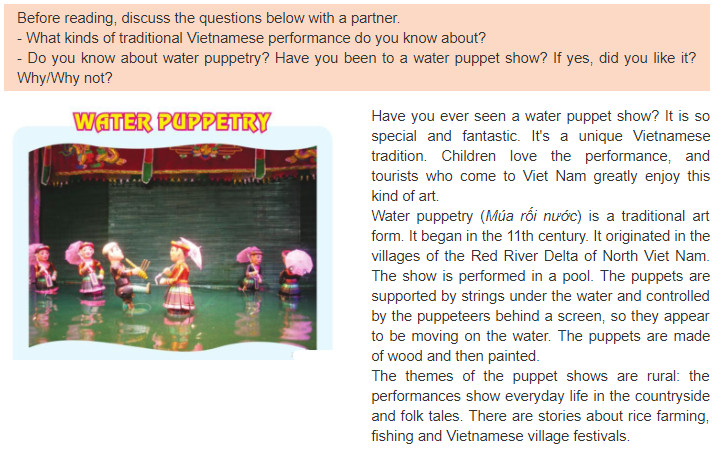tell something know about a traditional art form in region/ country

Những câu hỏi liên quan
what kind of traditional art form in VN do you know about
Vietnamese art has a long and rich history. The earliest examples of this art come from the Stone Age around 8,000 BC. For the thousand years under the domination of China beginning in the 2nd century BC, the influential Vietnamese influenced art certainly absorbed many influences from China, which also continued. even after independence from China in the 10th century. However, Vietnamese art has always retained many Vietnamese identities.
Like the literature of other countries in the world, Vietnamese literature consists of two parts: folklore and writing. Folk literature is the oral tradition of the people and literature consists of writing literature, literature and script language National language script....
Đúng 0
Bình luận (0)
Viết giúp mình 1 đoạn văn về chủ đề music and arts nha!
Topic: Music and arts
1. Tell some famous artists you know.
2. Tell some traditional art form in Viet Nam.
3. Tell somemusical instruments.
4. Make a short conversation to invite your friend to wath a water puppet show.
Viết giùm mình đoạn văn tiếng anh về music and arts nha !
Topic: Music and arts
1. Tell some famous artits you know.
2. Tellsome traditional art form in Viet Nam.
3. Tell some musical instruments.
4. Make a short conversation to invite your friend to watch a puppet show.
giúp mình mình đang cần gấp
Question 4
Talking about a trditional art form in Viet Nam
You should say :
- The name of a traditional art form
- When it began
- Where it orginated
- How it is performed
- What it is about
FINE ART
Silk Painting
Silk paintings are made by embroidering on the canvas of silk with sophisated themes and vibrant colors. Success of silk painting owes much to the quality of the silk because it is used directly as background. Its delicate and refined colors give the picture such harmony with the nature and excellent representation of Vietnamese landscapes and daily life.
The XQ Su Quan in Da Lat is very famous for silky embroidered paintings.
Lacquer
Vietnamese lacquer traditionally comes in only three colors - brown, black and vermilion. During 1930s, artists adopted a new technique called “chiseling” to produce richer color range and sense of distance.
The painting is made on wood. It is covered with a piece of cloth glued to it using the sap of the lacquer tree and then coated with a layer of the sap mixed with earth. The board is then sand papered and recoated with a layer of hot sap. After polishing, this gives a smooth black surface with a brilliant luster.
The painter uses hot lacquer to draw the outline of a picture and the colors are applied one by one, layer upon layer. Each coat dries slowly.
The finishing touches consist of polishing and washing the pictures. This process may seem brutal treatment for a work of art, but it is done with great care. This process leaves a brilliant surface on a painting.
Đúng 0
Bình luận (0)
talk about a tradilionl art form in viet nam
you should say
- the name of a traditional art form
-when it began
-where it originated
-how it is performed
-what it is about
giúp với mọi người ơi!!!!!!!!!!!!!!!ơ unit 4 music and arts lớp 7
tell something you know about the first unversity in VN and Chu Van An
Hi, class. Come into the next building of the Temple of Literature and let me tell you about Chu Van An. Chu Van An was considered the most famous teacher at the Imperial Academy and one of the most remarkable educators in Vietnamese history.
He was bom in 1292, in Thanh Tri District, Ha Noi. He was an honest man. He passed the royal examination. First he opened a school in his home village. Then, he became a teacher at the Imperial Academy. He taught many talented and successful students for the nation.
Later, he resigned and returned to his home village. For the rest of his life, Chu Van An continued his teaching career and wrote books. He died in 1370.
Đúng 0
Bình luận (0)
Maybe everyone knows 'Hanoi Temple of Literature'- Van Mieu Quoc Tu Giam - the first relic of Hanoi. It is said that 'Hanoi Temple of Literature' is one of the first universities in the world. Going to visit Hanoi except for Van Mieu, you will be deemed not to visit Hanoi. When you go to Hanoi Temple of Literature, you can explore the history and architecture of this monument.
Van Mieu-Quoc Tu Giam has two main vestiges, there are: Literature worship Confucius and Chu Van An- Quoc Tu Giam career, who has many good quality of the Vietnamese education South and Quoc Tu Giam. Hanoi Temple of Literature is the first national university in Vietnam with more than 700 years of operation (1076-1802) that has trained thousands of talents for the country.
According to history, the Temple of Literature was built in May 10-1070 of the reign of King Ly Thanh Tong. By 1076, King Ly Nhan Tong established Quoc Tu Giam, initially; it is the only place used for the prince and then expanding to receive students in the whole country.
The size of Van Mieu - Quoc Tu Giam is 54,331m2 including: Van Lake, Giam garden, inner self surrounded by brick walls. The inner self is divided into 5 zones. The first zone begins with the main entrance to the Great Chinese ports. The port gate has unique architecture of two storeys with stylized double dragon Le; inside it has a double dragon of the Nguyen dynasty. The second zone features with Khue Van Cac - a unique architecture built in 1085 (Nguyen dynasty), including 2 floors, 8 roots. Khue Van Cac usually organizes the poetic competition. Today, Khue Van Cac is taken as the symbol of Hanoi capital. The third zone has a square lake called Thien Quang Tinh. Two sides along the lake is two stele garden which store 82 stelae established from 1484 to 1780 in which name, hometown of the doctorate of 82 examination were sculpted. Step through the door into the Great to the Fourth named Bai Duong Van Mieu which has name of outstanding pupils of Confucius along with other famous culture of VietNam. The fifth zone is the old Temple of Literature - the location for the talent selection competitions in the past.
Nowadays, Hanoi Temple of Literature opens daily from 8 AM to 17 PM and cameras are allowed.
Đúng 0
Bình luận (0)
Van Mieu - Quoc Tu Giam is relic and rich diversity of the city's leading Hanoi, located in the south of Thang Long. Currently, it was the Prime Minister Vietnam put on the list ranked 23 national monuments in particular. Architectural ensemble Van Mieu - Quoc Tu Giam, including: Lake Van, the Van Mieu - Quoc Tu Giam and garden director and architectural subjects are Literature - a shrine to Confucius and the Temple of Literature - the first university Vietnam. Temple of Literature - Quoc Tu Giam mallet brick walls surrounding, inner space divided into five classes with different architectures. Each class that space is limited by the brick wall with three gates to communicate with each other (including the door between the two parties and two side doors). From outside to inside with the ports respectively: port of Literature, University of China, Dai Thanh and ergonomics. With over 700 years of operation has trained thousands of talents for the country. Now, the Temple of Literature where sights of domestic and foreign tourists as well as where the compliments for excellent student and also a place to organize the annual poetry on the fifteenth day of January. In particular, there is the element of today's officers to "good luck" before each exam
Đúng 0
Bình luận (0)
Xem thêm câu trả lời
SPEAKING Work in pairs. Look at the photo. Do you like the tattoo? Is it a form of art? Does it tell you anything about the woman's personality or not?

Regarding tattoos, they are a form of art for many people, and they can be a way of expressing oneself and conveying a message or identity. However, whether someone likes a tattoo or not is subjective and depends on personal taste.
In terms of the woman's personality, a tattoo can sometimes provide insight into her interests, values, or beliefs, but it's not always the case. It's important not to make assumptions or stereotypes based solely on someone's appearance.
(Về hình xăm, chúng là một loại hình nghệ thuật đối với nhiều người, và chúng có thể là một cách thể hiện bản thân và truyền tải một thông điệp hoặc danh tính. Tuy nhiên, việc ai đó thích một hình xăm hay không là chủ quan và phụ thuộc vào sở thích cá nhân.
Về tính cách của người phụ nữ, một hình xăm đôi khi có thể cung cấp cái nhìn sâu sắc về sở thích, giá trị hoặc niềm tin của cô ấy, nhưng không phải lúc nào cũng vậy. Điều quan trọng là không đưa ra các giả định hoặc định kiến chỉ dựa trên vẻ ngoài của ai đó.)
Đúng 0
Bình luận (0)
Viết đoạn văn về các chủ đề sau (dịch dùm mk với)
1) why must we keep personal hygiene?
2)What did you do to keep your school green and clean?
3)tell me something about your favorite artist?
4)describe a traditional food art you have seen or taken part in?
Giúp mk với mình ấn đúng cho
Chủ đề 4 nha!!!!!!!!!!!!!!
1. Pho (Phở)
This simple staple consisting of a salty broth, fresh rice noodles, a sprinkling of herbs and chicken or beef, features predominately in the local diet. Pho is cheap, tasty, and widely available at all hours.
(Sản vật đơn giản này bao gồm một bát canh nước dùng mặn, bún tươi, một rải rau thơm và thịt gà hoặc thịt bò, các gia viij chủ yếu trong chế độ ăn uống địa phương. Phở có giá rẻ, ngon, và phổ biến rộng rãi ở mọi khung giờ)
2. Goi cuon (Gỏi cuốn)Goi cuon is the best choice when you have eaten many fried food. The translucent parcels are first packed with salad greens, a slither of meat or seafood and a layer of coriander, before being neatly rolled and dunked in Vietnam’s favorite condiment — fish sauce.
(Gỏi cuốn là sự lựa chọn tốt nhất khi bạn ăn quá nhiều đồ chiên. Những miếng cuộn trong suốt đầu tiên cuốn gói với rau xà lách, một miếng thịt hoặc hải sản và một lớp rau mùi, trước khi được cuốn gọn gàng và nhúng trong gia vị yêu thích của Việt Nam – nước mắm.)
4. Gio (Giò)Gio is one of the traditional food in Tet. There are many types of “giò” such as: pork-pie, beep dumpling, pork and skin paste…Each type has a particular taste but the most important thing to make “giò” dish really attractive is that the fragrance of banana leaves and fish sauce combined in the piece of “giò”.
Giò là một loại thức ăn tuyển thống vào dịp Tết. Có nhiều loại giò: giò lụa, giò bò, giò bì……Mỗi loại có một hương vị đặc biệt, nhưng điều quan trọng nhất để làm cho “giò” món ăn thực sự hấp dẫn là mùi thơm của lá chuối và nước mắm kết hợp trong các mảnh “giò”.
5.Ô maiis produced for traditional method, since chosing material: kinds of sour fresh fruit like plum, apricot, dracontomelum, star, tamarind, kumquat, pineaple, canari, lemon. This product is for instant all year and you can enjoy with a pot of tea and a few friends to chat.
(Ô mai được sản suất theo các phương pháp truyền thống, từ việc chọn nguyên liệu: các loại trái cây tươi chua như mận, mơ, sấu, sao, me, quất, pineaple, canari, chanh. Sản phẩm được bán quanh năm và bạn có thể thưởng thức với một tách trà cùng một vài người bạn để trò chuyện.)
Đúng 0
Bình luận (1)
VII. Put in a suitable preposition and the correct form of the verb in brackets. 1. Thank you ................. (tell) us all about good news. 2. I’m tired .................... (study). I need a rest. 3. She’s very keen ................ (go) to art college.4. Some of us are interested .................... (start) a discussion group.5. The man was found guilty ......................... (steal) from his employer.6. Is this car capable ...................... (get) us all way to our hometown?7. John...
Đọc tiếp
VII. Put in a suitable preposition and the correct form of the verb in brackets.
1. Thank you ................. (tell) us all about good news.
2. I’m tired .................... (study). I need a rest.
3. She’s very keen ................ (go) to art college.
4. Some of us are interested .................... (start) a discussion group.
5. The man was found guilty ......................... (steal) from his employer.
6. Is this car capable ...................... (get) us all way to our hometown?
7. John is really excited ...................... (go) to Los Angeles.
8. People objected ................ (have) (wait) too long.
9. He insisted ................ (tell) the whole truth.
10. I believe .................. (discuss) things openly.
11. You ought to book in advance. you can’t rely.................... (find) hotel room
12. The tourists complained ...................... (not get) any sleep.
13. He apologized ..................... (not answer) my letter sooner.
14. I don’t approve....................... (smoke). I think it’s a disgusting habit.
15. He has succeeded................... (get) in touch with his old friend.
16 The heavy rain prevented the farmers ..................... (collect) the harvest.
17. People were annoyed.................... (not be) able to see properly.
18. He prefers (play) sports ................ (watch) them.
19. I’m grateful to her......................... (provide) me with so much information.
20. She’s not used .............................. (speak) in public.
1. Thank you .........for telling........ (tell) us all about good news.
2. I’m tired ..........of studying.......... (study). I need a rest.
3. She’s very keen .....on going........... (go) to art college.
4. Some of us are interested ........in starting............ (start) a discussion group.
5. The man was found guilty ...............about stealing......... (steal) from his employer.
6. Is this car capable ...........of getting........... (get) us all way to our hometown?
7. John is really excited ..............about going........ (go) to Los Angeles.
8. People objected ........to having waited........ (have) (wait) too long.
9. He insisted ....on being told............ (tell) the whole truth.
10. I believe .......in discussing........... (discuss) things openly.
11. You ought to book in advance. you can’t rely.........on finding........... (find) hotel room
12. The tourists complained .......about not getting............... (not get) any sleep.
13. He apologized .............for not answering........ (not answer) my letter sooner.
14. I don’t approve................of smoking....... (smoke). I think it’s a disgusting habit.
15. He has succeeded...in getting................ (get) in touch with his old friend.
16 The heavy rain prevented the farmers ..................from collecting... (collect) the harvest.
17. People were annoyed.............with not being....... (not be) able to see properly.
18. He prefers (play)to play sports .........to watching....... (watch) them.
19. I’m grateful to her.............for providing............ (provide) me with so much information.
20. She’s not used .............to speaking................ (speak) in public.
Đúng 2
Bình luận (1)
1.for telling
2.of studying
3.on going
4.in starting
5.of stealing
6.of getting
7.about going
8.to having waited
9.on telling
10.in discussing
11.on finding
12.of not getting
13.for not answering
14.of smoking
15.in getting
16.from collecting
17.at not being
18.to playing, than watching
19.for providing
20.to speaking
Đúng 2
Bình luận (0)



















